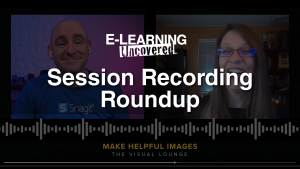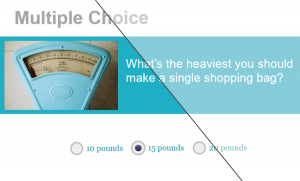How to Design Attention-Grabbing E-Learning
Every time I sit down to watch a movie, I hear the same opening music that studios have been using for decades. Upon hearing these few measures, I let out a breath, put away my phone, and give the story my full attention. I’ve spent so many years enjoying movies, it’s almost Pavlovian at this point. I tune out everything else.
I think it’s safe to say that e-learning has to work a little harder than a movie to get people to tune in. But attention-grabbing e-learning is essential in today’s world. With so many distractions, you need to show your learners why your course matters. A slide of course objectives won’t cut it, not as the opening of your course. In order for your content to have a chance at making it to long-term memory, you have to hook the learner from the start.
Here are four ways to design attention-grabbing e-learning.
1. Tell a story.
Stories do more than entertain. As humans, we’re hard-wired to respond to them. Open your e-learning with a story with a protagonist people can relate to. Include a character who is facing a challenge they know. You’ll get their attention and show them that you understand their world.
Resources:
2. Make it interactive.
Making your course interactive is an effective way to engage your learners. Try starting your course with an interactive scenario to put the learner on the spot. This will get them thinking about the problem and evaluating their ability to address it. Include feedback and then direct them to information that will help them.
Resources:
3. Personalize it.
Another way to create attention-grabbing e-learning is to let the learner personalize the course. Before learners begin the course, let them select a character or an avatar. You can also let the learners enter their names for more personalized content. “Sharon, you’ve missed something critical,” will get my attention faster than generic feedback. If appropriate, let them pick which module they take first. Or let the learner select the role or position for the character in the training. These little choices add up and lead to intellectual investment in the experience.
Resources:
4. Write in a conversational tone.
If you plan to include audio narration in your e-learning course, try scripting it in a conversational tone. Unlike formal business writing, you have more freedom to break the rules and write the way people actually speak. When you speak (or write) directly to your learners, in a style that doesn’t make them cringe, you give them a better experience. Plus, it’s up to an actual person to deliver the narrated portion of your course. You’ll want it to sound natural when they do.
Resources:
- Creating Conversational Narration for Your E-Learning
- Tips for Transitioning From Copywriting to E-Learning
- Tips for Working with E-Learning Voice-Over Talent
What ways have you designed attention-grabbing e-learning? Share your ideas by commenting below!

 Previous Post
Previous Post Next Post
Next Post



